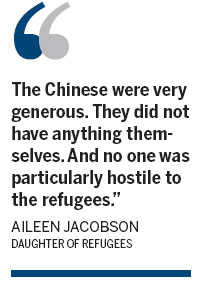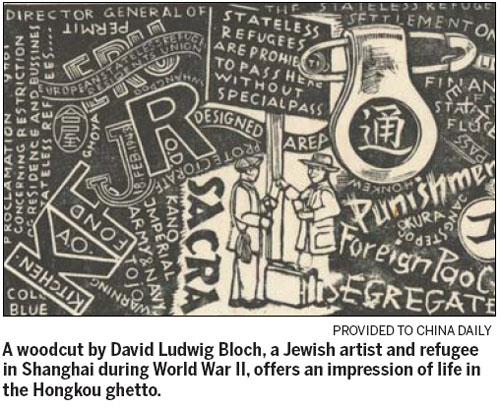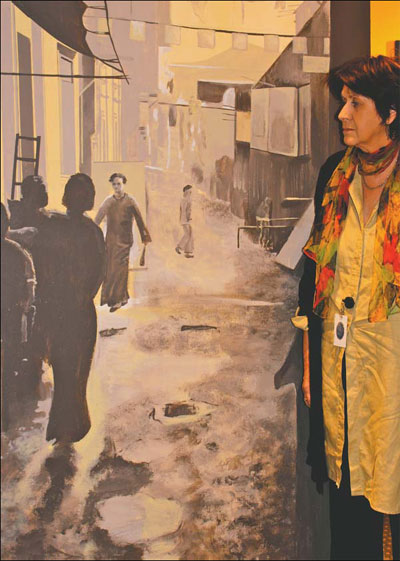Recalling Shanghai as wartime refuge for European Jews
Updated: 2012-08-10 11:04
By China Daily and Molly Bodurtha in New York (China Daily)
|
||||||||
|
Curator Renata Stein looks at a mural included in Destination Shanghai, at New York's Center for Jewish History. Molly Bodurtha / For China Daily |
Hunched and weary, the "stateless refugees" lined up out the door of a soup kitchen in pre-revolutionary China during the winter of 1937.
Peering anxiously at the place that would soon become their home, the men, women and children who gathered that day in search of a meal were the most recent group of German and Austrian Jews to flee Nazi-occupied Europe for the promising shores of the Far East.
The moment is immortalized in a photo included in Destination Shanghai: The Jewish Community of Shanghai, 1936-1949, at the Center for Jewish History in New York.
The exhibit, which opened in late June and continues through October, tells the story of a far-flung outpost of the post-World War II Jewish diaspora.
But the real subject of Destination: Shanghai, says curator Renata Stein, isn't only the plight of European Jews but also the hospitality and empathy of their Chinese hosts.
Stein and her colleagues at New York's Leo Baeck Institute organized the exhibit to encourage some of the era's surviving refugees to tell their stories.
"We were also interested in having it now so that some of the people who were there would still see it, and get the idea that we are very interested in their story," Stein told China Daily.
On the eve of Nazi occupation of Europe, Jews in many countries noted rising anti-Semitism and quickly applied for emigration, with many fortunate to escape the horrors of the Holocaust.
The world's superpowers, however, didn't always offer help.
For Franz Friedlander, an Austrian whose journey to Shanghai is highlighted in the exhibit, the United States initially represented a potential haven. But as his application for a visa in 1938 reveals, Friedlander was assigned to a waiting list along with thousands of other would-be emigrants. A brief form notified him that "no details could be released as to if or when a visa would be granted".
German Jewish refugee, Alfred Buchler was 12 at the time his application for a visa to Chile was processed. The Chilean consulate issued visas to Buchler and other emigrants, only to invalidate them soon after.
For the wave of people struggling to find somewhere to resettle, the only hope seemed to be Shanghai, an international city that didn't require an entrance visa. It was a place that foreigners were freer to come and go than in the rest of China at the time.

While gaining entry to Shanghai was relatively easy, obtaining permission to leave Germany was nearly impossible. A citizen of a Nazi-occupied country needed an exit visa to emigrate.
In the wake of Kristallnacht, the November 1938 pogroms in Austria and Germany, the Chinese ambassador to Austria, Ho Fengshan, began issuing Austrian Jews emigration visas to China. The Baeck Institute houses the papers Ho issued to Austrian citizens Oskar Fiedler and Hermine Moser on July 20, 1938, and June 9, 1939, respectively. Although his bold actions directly disobeyed orders from his immediate superior, and resulted in a demerit in his file, the diplomat believed the lives saved outweighed risks to his career.
In 2000, Ho was posthumously given a Righteous Among the Nations award by Yad Vashem, the organization that runs Israel's official Holocaust museum, for "humanitarian courage" at a time of moral collapse in the world. Because of his sacrifices, 1,200 Austrian Jews were able to escape a grim fate. Some were even released from concentration camps to begin their search for freedom on the journey to Shanghai.
The arrival of many European Jews to the Chinese city in 1937 came at a trying time. In July of that year, Japan launched a full-scale invasion of China, sparking the War Against Japanese Aggression.
Shanghai was occupied and reduced to rubble. Along with occupation, Chinese residents of Shanghai would endure severe inflation from 1938 to 1943 - money that once bought a meal's worth of food for a family of 10 would later buy just 4 ounces of margarine, according to the exhibit.
Aileen Jacobson, the daughter of two Jewish "Shanghai-lander" refugees, caught the exhibit's opening on June 15 and was back on a recent Monday for a second look. Although her parents relocated to Atlanta shortly after she was born in 1947, Jacobson grew up hearing about the hunger her parents endured in Shanghai before they left.
"In the mornings, there would be people dead on the street," she said. "They would die overnight and a wagon would come pick them up in the morning.
"They would only be Chinese bodies, because the Jews had that little bit of that safety net," referring to support from foreign-aid organizations.
While some histories and novels of the period have portrayed Jews as being tolerated but not necessarily welcomed in Shanghai, the Baeck Institute tells a story that casts the Chinese in a more altruistic light. Despite abject poverty and starvation in the city, the Jewish arrivals received substantial care and aid from the local community.
The soup kitchens could afford to feed each person 1,500 calories a day, which was "enough to keep one thin but alive," according to Jacobson, whose parents took meals there regularly. "They knew these people were poor refugees - not with any particular knowledge of the Jews' circumstances, but refugees nonetheless."
The exhibit also explains how the Chinese community safeguarded the Jews as pressure mounted from Germany to either exterminate or deport the emigrants. In 1942 Colonel Joseph Meisenger of the Gestapo, known as the "Butcher of Warsaw", visited Shanghai to suggest that Japanese authorities deport the 20,000 Jews living there to Chongming, a desolate island at the mouth of the Yangtze River, where a concentration camp could be built.
The Chinese used what little power they had to thwart the Nazi officer's proposal, and passed a proclamation ordering all of the city's Jewish residents into the Hongkou ghetto of downtown Shanghai.
After the Jews had been forcibly relocated to the tenements of Hongkou, it was then decreed that they weren't allowed to leave the ghetto without authorization and work papers issued by a Japanese official, Kanoh Goya.
The exhibit makes clear that even though the Jews escaped Europe, they were still subjected to discrimination by the Japanese occupiers controlling Shanghai.
The exhibit features just a sliver of the Center for Jewish History's archival material on China, culled from publications of the time, aid organizations' tattered snapshots of immigrants, and refugees' personal photos and papers.
An entire wall of prints depicts the cramped hostels where foreigners and Chinese lived, the Jewish schools that sprouted in the middle of Chinese neighborhoods, and the small businesses, such as the Ollendorf sausage stand, that had gave rise to the moniker Little Vienna.
"The Chinese were very generous," Stein said. "They did not have anything themselves. And no one was particularly hostile to the refugees."
When Jacobson recently traveled back to Shanghai to explore her heritage, she found her parents' old Shanghai apartment, now lost in the twisting, labyrinthine lanes of old Hongkou. She recalled standing at the building's gate, chatting in English with her husband, when an elderly Chinese man exited and did a double-take, pausing in front of the couple. He turned to her with a knowing smile and said in halting English, "Welcome home."


 Relief reaches isolated village
Relief reaches isolated village
 Rainfall poses new threats to quake-hit region
Rainfall poses new threats to quake-hit region
 Funerals begin for Boston bombing victims
Funerals begin for Boston bombing victims
 Quake takeaway from China's Air Force
Quake takeaway from China's Air Force
 Obama celebrates young inventors at science fair
Obama celebrates young inventors at science fair
 Earth Day marked around the world
Earth Day marked around the world
 Volunteer team helping students find sense of normalcy
Volunteer team helping students find sense of normalcy
 Ethnic groups quick to join rescue efforts
Ethnic groups quick to join rescue efforts
Most Viewed
Editor's Picks

|

|

|

|

|

|
Today's Top News
Health new priority for quake zone
Xi meets US top military officer
Japan's boats driven out of Diaoyu
China mulls online shopping legislation
Bird flu death toll rises to 22
Putin appoints new ambassador to China
Japanese ships blocked from Diaoyu Islands
Inspired by Guan, more Chinese pick up golf
US Weekly

|

|








